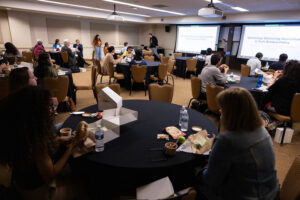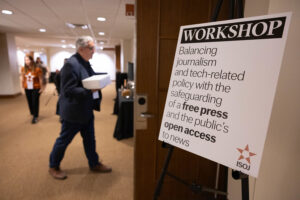Across the world, governments are pursuing public policy to help fund journalism. In the pursuit of effective policy, some states and countries have created definitions of journalism to help determine which individuals and organizations qualify. But in the digital age, creating an adequate definition is easier said than done.

Attendees of the 25th ISOJ grab lunch April 13 while hearing a discussion about the crossroads of journalism and tech public policy. (Patricia Lim/Knight Center)
“How is news defined today? How is journalism defined today? And journalists defined today?,” Amy Mitchell asked a room full of media professionals during a workshop at the 25th annual International Symposium on Online Journalism (ISOJ). The workshop was led by Mitchell, the founding executive director at the Center for News, Technology and Innovation (CNTI), an independent non-advocacy research center started in 2023. The center works with journalists, technologists and civil society groups toward the mission of sustaining a healthy news ecosystem.
“To be able to address the opportunities and the challenges of the digital news environment, we all need to work together,” Mitchell said.
During lunch on the second day of the 25th ISOJ, about 25 people joined the workshop titled “Balancing Journalism and Tech Related Policy with the Safeguarding of a Free Press and the Public’s Open Access to News,” for a discussion about how journalists define themselves and the work they do. The workshop also provided a preview of what CNTI will research later this year.
The Center for News, Technology and Innovation is embarking on research to understand not only how journalists define their work, but also how the public defines journalism. Through a series of focus groups and surveys that will be deployed in Australia, Brazil, South Africa and the United States, the center will explore these questions, unraveling how the media sees itself versus how news consumers see the media, and the public policy implications of various definitions.
Senior Research Fellow at CNTI Connie Moon Sehat said the center is “currently seeking collaborations with journalist organizations,” to help develop and deploy the survey. During the workshop, the participants generally agreed that a set of ethical standards sets journalists apart from anyone that shares information with an audience, such as a YouTube host or blogger.
Journalists must have “a commitment to a set of ethics and principles,” including a “sensitivity to conflict of interest,” said Theresa Lalonde, faculty instructor at the British Columbia Institute of Technology and a former reporter and producer for the Canadian Broadcasting Corporation.
Across the world, government bodies including the European Union, Australia, and some states within the U.S. have attempted to define journalism as a matter of public policy. The definitions generally include some kind of ethical standard or mission to support the public interest, but they also can include requirements about the size and revenue stream an organization needs to qualify.
“The reason those definitions are there is to get money,” said Jeff Jarvis, a professor at the Craig Newmark Graduate School of Journalism at the City University of New York. “You have to be an official journalist or journalistic organization” to qualify, Jarvis said, adding that “we need to interrogate that.”

A lunch workshop at the 25th ISOJ on April 13 featured a discussion of how best to define journalism as related to tech public policies. (Patricia Lim/Knight Center)
Jarvis appeared on a panel the previous day at ISOJ where he laid out his reasons to oppose the California Journalism Preservation Act, saying that it will mostly benefit large media companies owned by hedge funds while leaving out small, independent publishers and many Black and Latino publications.
The group began a discussion of edge cases where individuals or organizations may be doing journalism without fitting neatly into standard definitions. Mitchell brought up the example of Hugo Travers, who spoke at a panel earlier in the day about how his work in France on the YouTube channel Hugo Décrypte blurred the lines between journalism and digital content creation.
Travers had described his struggles obtaining press passes for his staff of 25 people because the YouTube channel initially did not have a website. Another participant in the workshop described the difficulty that photographers for Wikipedia encountered trying to obtain press credentials to take pictures at major events.
“The lack of definition of journalist in open societies is a feature not a bug,” said Richard Gingras, vice-president of news at Google.
With so much variability in what can be considered journalism and fast-changing technological changes, some participants at the ISOJ workshop were hopeful that the public would also begin changing their perspectives about the media.
“The conversation about our craft has to change in order for people to be able to engage with us more meaningfully,” Lalonde said.
ISOJ is a global online journalism conference organized by the Knight Center for Journalism in the Americas at the University of Texas at Austin. In 2024, it is celebrating 25 years of bringing together journalists, media executives and scholars to discuss the impact of the digital revolution on journalism.